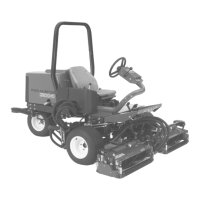18
BEFORE OPERATING
IMPORTANT: Group 1 fluids are recommended for use
at typical ambient temperatures of 32F (0 C) to 105F
(41C). The ISO Type 46/68 fluid has been found to
offer optimal performance in a wide range of
temperature conditions for the average user. The
Universal Tractor Fluids offer similar performance for
those who prefer them, with perhaps some slight loss
of efficiency at high ambient temperatures compared
to the Type 46/68 fluids.
Group 2 fluids are recommended for heavyduty use in
hot climates where ambient temperatures range from
about 70F (20C) to 120F (49C). Use at lower
ambient temperatures may result in hard starting,
increased engine laboring while cold, sluggish or
nonoperating spool valves while cold and high filter
backpressure due to the higher viscosity of these
fluids.
Note: When changing from one type of hydraulic fluid
to another, be certain to remove all the old fluid from the
system, as some fluids are incompatible with others.
Group 3 Hydraulic Fluid (Biodegradable)
ISO VG 32/46 antiwear hydraulic fluid
Mobil EAL 224H
Note: This biodegradable hydraulic fluid is not
compatible with the fluids in Group 1 and 2.
Note: When changing from standard fluid to the
biodegradable type, be certain to follow approved
flushing procedures as published by Mobil. Contact
your local Toro Distributor for details.
IMPORTANT: Use only types of hydraulic fluids
specified. Other fluids could cause system
damage.
Note: A red dye additive for the hydraulic system fluid
is available in 2/3 oz. bottles. One bottle is sufficient for
4-6 gal. of hydraulic fluid. Order Part No. 44-2500
from your Authorized Toro Distributor.
Figure 34
1. Hydraulic Tank Cap
1
1. Position machine on a level surface, lower the
cutting units and stop the engine.
2. Clean area around filler neck and cap of hydraulic
tank. Remove cap from filler neck.
3. Remove dipstick from filler neck and wipe it with a
clean rag. Insert dipstick into filler neck; then remove it
and check level of fluid. Fluid level should be within 1/4
inch of mark on dipstick.
4. If level is low, add appropriate fluid to raise level to
full mark.
5. Install dipstick and cap onto filler neck.
CHECK TIRE PRESSURE
The tires are over-inflated for shipping. Therefore,
release some of the air to reduce the pressure. Correct
air pressure in tires is 14 -18 psi.
IMPORTANT: Maintain recommended pressure in all
tires to assure a good quality-of-cut and proper
machine performance.
DANGER
Low tire pressure decreases the machine's
sidehill stability. Do not under inflate tires. This
could cause a rollover, which may result in per
sonal injury or death.
CHECK REEL TO BEDKNIFE CONTACT
Each day before operating, check reel to bedknife
contact, regardless if quality of cut had previously been
acceptable. There must be light contact across the full
length of the reel and bedknife (refer to Adjusting Reel
to Bedknife in Cutting Unit Operator's Manual).
CHECK TORQUE OF WHEEL NUTS
WARNING
Torque wheel nuts to 4565 ft-lb after 14
hours of operation and again after 10 hours of
operation and every 200 hours thereafter.
Failure to maintain proper torque could result
in failure or loss of wheel and may result in
personal injury.

